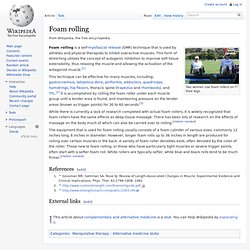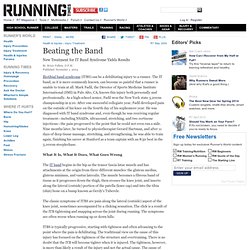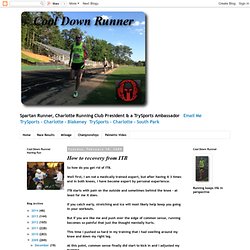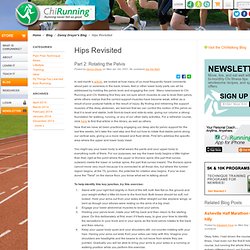

Runner's Knee Stretches. It band pain - cyclingphysio.com. Foam rolling. Two women use foam rollers on their legs.

Foam rolling is a self-myofascial release (SMR) technique that is used by athletes and physical therapists to inhibit overactive muscles. This form of stretching utilizes the concept of autogenic inhibition to improve soft tissue extensibility, thus relaxing the muscle and allowing the activation of the antagonist muscle.[1] This technique can be effective for many muscles, including: gastrocnemius, latissimus dorsi, piriformis, adductors, quadriceps, hamstrings, hip flexors, thoracic spine (trapezius and rhomboids), and TFL.[2] It is accomplished by rolling the foam roller under each muscle group until a tender area is found, and maintaining pressure on the tender areas (known as trigger points) for 30 to 60 seconds.[3] While there is currently a lack of research completed with actual foam rollers, it is widely recognized that foam rollers have the same effects as deep-tissue massage.
References[edit] External links[edit] It band rolling - cyclingphysio.com. Foamroller_exercises. A Runner's Guide to ITBS. Iliotibial band syndrome (ITBS) is the most common cause of pain on the outside of the knee in runners, with an incidence as high as 12% of all running-related overuse injuries.

Although it is not difficult to diagnose, it can be a challenge to treat, especially in higher mileage runners who place enormous loads on their bodies. This article has been written to help the runner diagnose, understand and begin to treat IT band friction syndrome. WHAT IS THE ILIOTIBIAL BAND? The IT band is not a muscle. It is a thick band of tissue called fascia that starts on the outside of the hip, passes down the outside of the thigh and inserts into the side of the patella (knee cap) and the tibia, (shin bone). Beating the Band. Iliotibial band syndrome (ITBS) can be a debilitating injury to a runner.

The IT band, as it is more commonly known, can become so painful that a runner is unable to train at all. Mark Fadil, the Director of Sports Medicine Institute International (SMI) in Palo Alto, CA, knows this injury both personally and professionally. Treatments.
How to recovery from ITB. So how do you get rid of ITB.

Well first, I am not a medically trained expert, but after having it 3 times and in both knees, I have become expert by personal experience. ITB starts with pain on the outside and sometimes behind the knee - at least for me it does. If you catch early, stretching and ice will most likely help keep you going in your workouts. But if you are like me and push over the edge of common sense, running becomes so painful that just the thought mentally hurts. This time I pushed so hard in my training that I had swelling around my knee and down my right leg. How to Treat Injuries Like an Elite: Healing ITBS in Five Days. Two weeks ago, I set out to run 11 miles with a few 30 second sprints near the end in my old Nike XC spikes.

It was supposed to be a standard distance run with some turnover work, but it ended badly with tightness in my IT band at the knee insertion. Luckily, I took some very proactive steps to aggressively treat the problem and I want to explain how to treat injuries so you can limit their impact on your training. After I ran 67 minutes, I changed into my old spikes (which didn’t have any spikes screwed in) and ran 4×30 seconds hard with a 45 second walking recovery. I noticed a few things as I was doing this workout: The spikes were very stiff and I had a hard time running comfortably in them.Being stiff, running very fast on asphalt was a bad idea. As I was finishing my ten minute warm-down, I could feel the outside of my left knee start to get tight where the IT band inserts. Aggressive Injury Treatment Stop Running.
Increase Strength. Massage the Injured Area. Rest or decrease mileage. Increase Cadence. Slow running worse. Less 15 degrees c warm knee - long pants. Anti inflammatories. ITB strap. KT tape. Running Form. Relax, Read foot sticky, hold longer to force hip back. Pelvis exercises. Part 2: Rotating the Pelvis In last month’s article, we looked at how many of us most frequently heard comments about pain or soreness in the back, knees, feet or other lower body parts can all be addressed by holding the pelvis level and engaging the core .

Many newcomers to Chi Running and Chi Walking find they are not sure which muscles to use to level their pelvis, while others realize that the correct support muscles have become weak, either as a result of poor postural habits or the result of injury. By finding and retraining the support muscles of the deep abdomen, we learned that we can control the motion of the pelvis so that it is level and stable, both front-to-back and side-to-side, giving our column a strong foundation for walking, running, or any of our other daily activities. For a refresher course, click here to find that article in the library, as well as others. You might say your lower body is what wears the pants and your upper body is everything north of there. New Shoes.